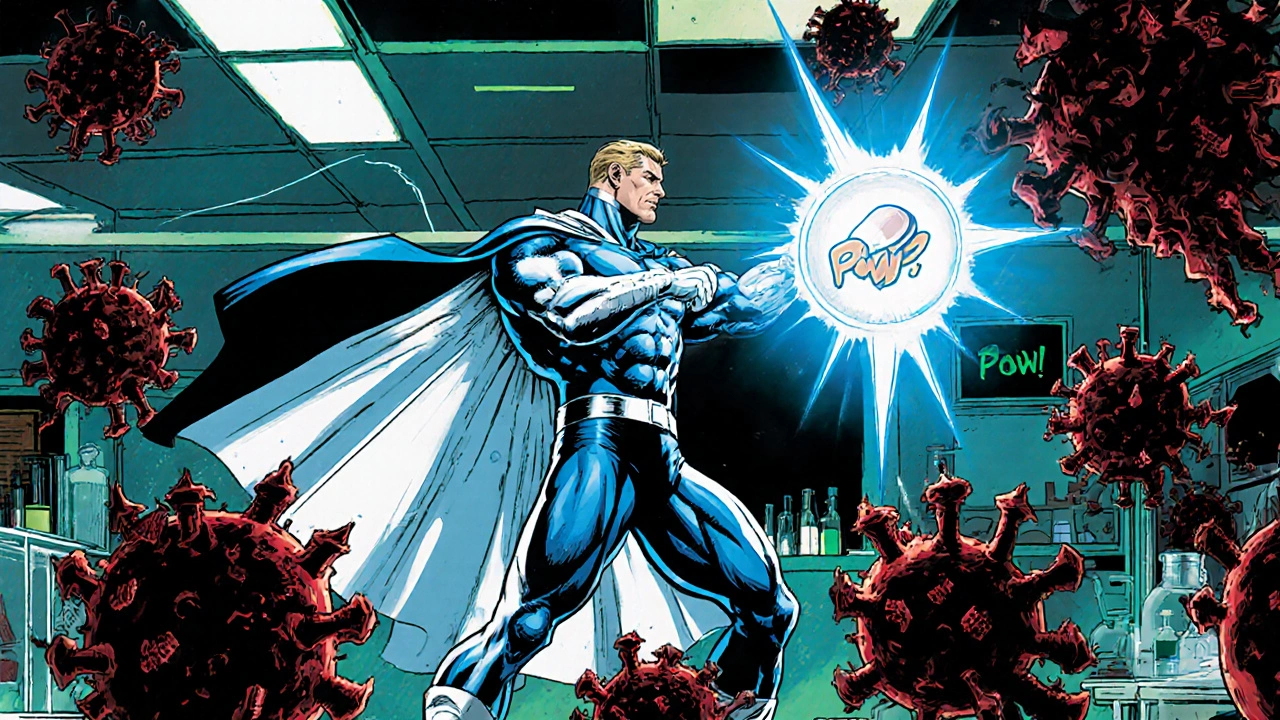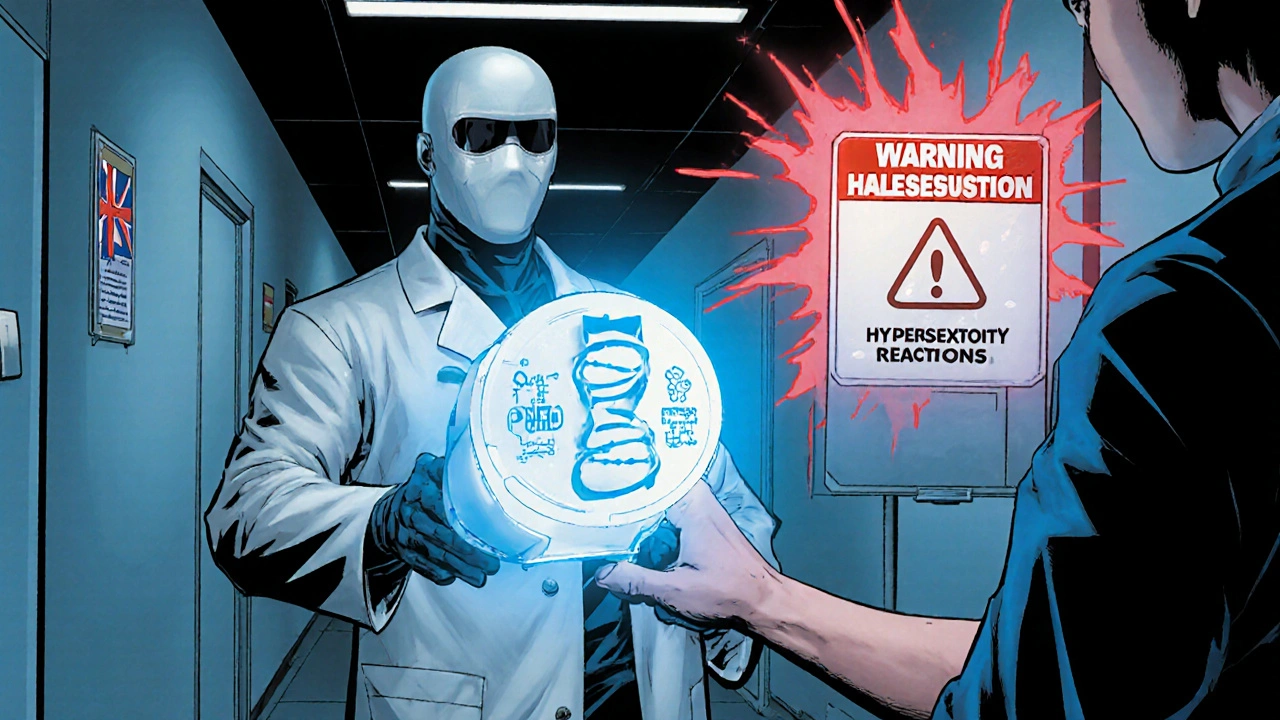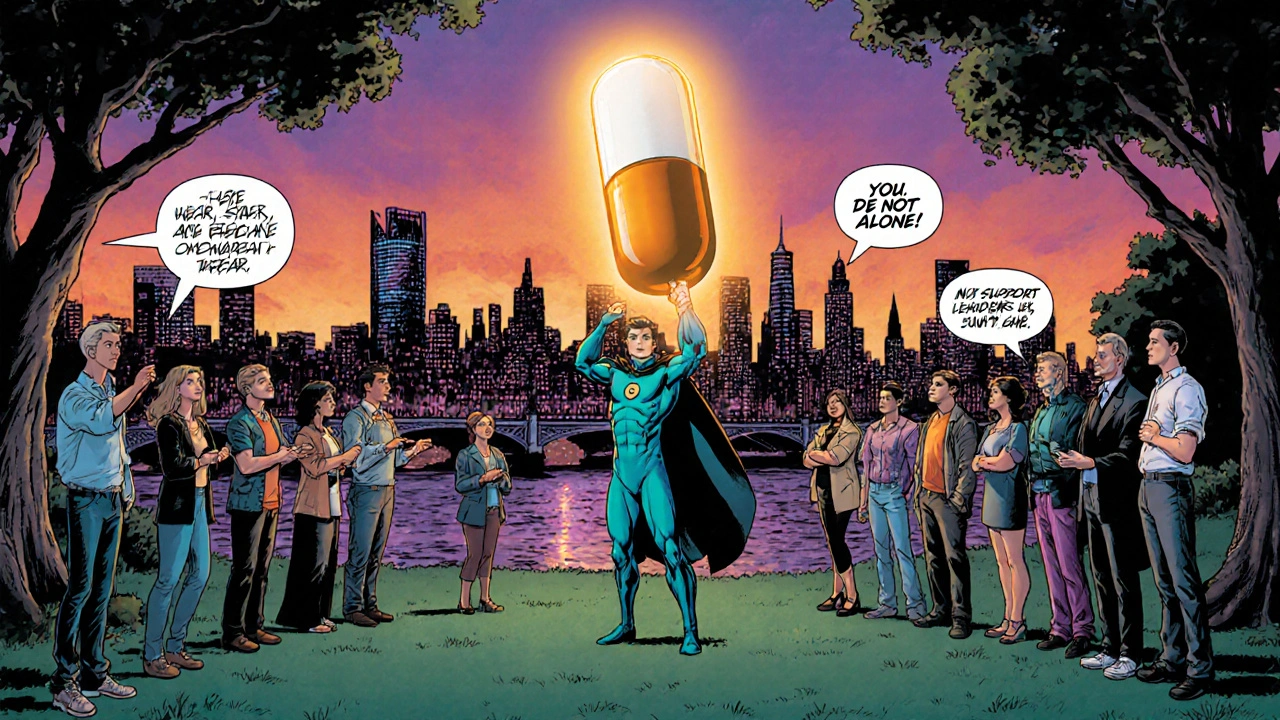
HLA-B*57:01 Risk Assessment Tool
Abacavir Safety Assessment
This tool helps determine your risk of abacavir hypersensitivity reaction based on HLA-B*57:01 genetic testing results. This critical test prevents potentially life-threatening reactions.
Results will appear here after assessment.
Important Information
Key facts:
- Abacavir hypersensitivity reaction affects 5-8% of untreated patients without HLA-B*57:01 testing
- Risk jumps to 70% in HLA-B*57:01 positive individuals
- Symptoms typically appear within first 6 weeks of treatment
- This reaction can be life-threatening if not stopped immediately
Community Support Resources
Strong community support improves medication adherence and overall wellbeing for HIV patients. Consider these resources:
- Local HIV support groups
- Online communities (e.g., AIDS.gov, The Well Project)
- NGO programs like AIDS Foundation East Bay
- Peer mentorship programs
Key Takeaways
- Abacavir is an NRTI that helps keep HIV viral load low when taken as prescribed.
- Testing for the HLA‑B*57:01 allele prevents a potentially life‑threatening hypersensitivity reaction.
- Strong community support improves medication adherence and overall wellbeing.
- Peer groups, NGOs, and online forums each offer unique benefits for HIV patients.
- When choosing a regimen, compare side‑effect profiles, dosing convenience, and resistance barriers.
When managing HIV, Abacavir is a nucleoside reverse transcriptase inhibitor (NRTI) that blocks the virus from copying its genetic material. Adding a solid support network can dramatically improve treatment outcomes.
The drug Abacavir is often combined with lamivudine and either zidovudine or dolutegravir, forming fixed‑dose combos such as Triumeq. This simplifies dosing to one pill a day for many patients, which is a key factor in staying adherent.
What Is Abacavir and How Does It Fit Into Antiretroviral Therapy?
Human Immunodeficiency Virus (HIV) attacks CD4+ T‑cells, weakening the immune system. Antiretroviral therapy (ART) works by targeting different stages of the virus’s life cycle. Abacavir belongs to the NRTI class, mimicking the natural building block guanosine. Once inside infected cells, it gets phosphorylated and then gets incorporated into the viral DNA chain, causing premature termination.
Standard adult dosing for Abacavir is 300mg once daily, taken with food to improve absorption. The drug reaches steady‑state concentrations in about a week, and therapeutic drug monitoring is rarely needed unless the patient has renal impairment.

Benefits, Risks, and the Critical Role of HLA‑B*57:01 Testing
Abacavir’s main advantage is its relatively mild metabolic side‑effect profile compared with older NRTIs such as zidovudine. Patients often report fewer nausea episodes and less lipodystrophy. However, a rare but serious hypersensitivity reaction can occur in about 5-8% of untreated individuals.
Genetic screening for the HLA‑B*57:01 allele is now standard practice in the UK and many other countries. Those who test positive should avoid Abacavir entirely, as the risk of hypersensitivity jumps to 70%.
Typical signs of the reaction include fever, rash, gastrointestinal upset, and respiratory symptoms. If any of these appear within the first six weeks of therapy, the drug must be stopped immediately and the patient evaluated for possible hospitalization.
Why Community Support Is a Game Changer for Adherence
Adherence rates of 95% or higher are crucial for maintaining viral suppression (viral load the amount of HIV RNA circulating in the blood <50 copies/mL). Studies from the British HIV Association in 2023 show that patients who regularly attend peer‑support meetings are 30% more likely to stay on regimen without missing doses.
Community support addresses three core barriers:
- Stigma: Sharing experiences normalises living with HIV and reduces isolation.
- Knowledge gaps: Group members often exchange tips on managing side effects, simplifying pharmacy pickups, and navigating NHS referrals.
- Emotional fatigue: Regular check‑ins provide a mental health buffer, lowering the risk of depression‑related non‑adherence.
Types of Community Support You Can Tap Into
Peer support groups (organized gatherings of people living with HIV, either in‑person or online) are often run by charities such as the Terrence Higgins Trust. They offer weekly meetings, mentorship programmes, and social events.
Non‑governmental organisations (NGOs) provide practical assistance: free or subsidised transport to clinics, medication delivery services, and legal advice for employment discrimination.
Online forums and social media groups-like HIV‑Positive UK on Facebook-give 24/7 access to advice and emotional support, especially useful for those in remote areas of England.
Professional counseling, usually covered by the NHS, helps patients process the emotional impact of diagnosis and develop coping strategies for medication fatigue.

Practical Steps to Build Your Support Network
- Contact your local HIV specialist nurse and ask for a list of nearby peer‑support groups.
- Register for a free account on a reputable online forum; verify that moderators are healthcare‑trained.
- Ask your pharmacy if they offer a medication reminder service or blister‑pack delivery.
- Schedule a counseling session through the NHS mental‑health pathway; bring a list of concerns about side effects.
- Consider volunteering with an HIV charity; teaching others reinforces your own adherence habits.
How Abacavir Stacks Up Against Other NRTIs
| Drug | Typical Dose | Key Side Effects | Resistance Barrier | HLA‑B*57:01 Concern |
|---|---|---|---|---|
| Abacavir | 300mg once daily | Hypersensitivity (genetic), mild nausea | High | Yes - must test |
| Tenofovir disoproxil fumarate (TDF) | 300mg once daily | Kidney toxicity, bone loss | Moderate | No |
| Zidovudine | 300mg twice daily | Anemia, lipodystrophy | Low | No |
| Lamivudine | 150mg twice daily | Generally well tolerated | Moderate | No |
When choosing a regimen, weigh the convenience of once‑daily dosing and the high resistance barrier of Abacavir against the need for HLA‑B*57:01 screening. For patients who test negative, Abacavir offers a clean side‑effect profile and fits well with community‑based adherence programs.
Frequently Asked Questions
Can I take Abacavir if I’m pregnant?
Current UK guidelines consider Abacavir safe in pregnancy when the mother tests negative for HLA‑B*57:01. The drug does not appear to increase birth defects, but regular monitoring of liver function is advised.
How quickly can I see my viral load drop after starting Abacavir?
Most patients achieve an undetectable viral load (<50 copies/mL) within 8‑12 weeks of consistent adherence, assuming the rest of the regimen is effective.
What should I do if I miss a dose?
Take the missed dose as soon as you remember, unless it’s almost time for the next dose. In that case, skip the missed pill and continue with the regular schedule. Never double‑dose.
Where can I find local peer‑support groups?
Start by asking your HIV specialist nurse for a list of groups in Bristol or nearby cities. Organisations such as the Terrence Higgins Trust maintain online directories of in‑person meetings.
Is there a cost for HLA‑B*57:01 testing?
The test is fully covered by the NHS for anyone prescribed Abacavir. You’ll usually have the blood draw at your local clinic before the medication is started.
Integrating medical knowledge about Abacavir with strong community connections creates a safety net that helps patients stay on track, avoid serious side effects, and keep their viral load undetectable. Whether you’re a newly diagnosed individual or a long‑term survivor, leaning on peers, charities, and professional services can make all the difference.
David McClone
August 1, 2025 AT 05:20Oh great, another reminder that if you skip the HLA‑B*57:01 test you’re basically signing up for a fireworks show in your bloodstream – who needs that drama?
Jessica Romero
August 1, 2025 AT 22:00When we dissect the mechanistic underpinnings of abacavir pharmacodynamics, we encounter a cascade of intracellular phosphorylation events that culminate in chain termination during reverse transcription. The nucleoside analogue, structurally analogous to guanosine, is first phosphorylated by host kinases to its active triphosphate form. This active metabolite competes with the natural substrate deoxyguanosine triphosphate for incorporation into the nascent viral DNA. Once incorporated, the absence of a 3′‑hydroxyl group precludes phosphodiester bond formation, effectively halting elongation. Clinically, this translates to a reduction in viral replication capacity, which is reflected in lowered plasma HIV‑RNA copies. The adherence to a once‑daily 300 mg regimen is bolstered by the drug’s favorable half‑life, permitting steady‑state concentrations within approximately seven days. However, the pharmacokinetic profile is not the sole determinant of therapeutic success; immunogenetic screening for HLA‑B*57:01 is a prerequisite to mitigate hypersensitivity risk. The allele’s peptide‑binding groove presents abacavir‑derived epitopes to CD8⁺ T‑cells, precipitating a cytokine storm in susceptible individuals. Evidence from multinational cohort studies indicates that the incidence of hypersensitivity escalates from 5‑8 % in untested populations to over 70 % in carriers of the allele. Consequently, national guidelines now mandate pre‑emptive genotyping before initiation. From a health‑economics perspective, the cost of a single HLA‑B*57:01 assay is dwarfed by the expense associated with emergency care and hospitalization due to severe reactions. Moreover, the psychosocial burden imposed by a delayed diagnosis can erode patient trust in the care continuum. Integration of community support networks, such as peer mentorship programs and localized support groups, further amplifies adherence metrics by addressing stigma and providing real‑world coping strategies. In practice, clinicians should couple the genetic test result with a structured education session on early symptom recognition, ensuring patients are primed to act within the critical six‑week window. Finally, the confluence of precision medicine and community empowerment epitomizes the modern paradigm in HIV management, where molecular diagnostics and social scaffolding co‑exist to optimize outcomes.
Michele Radford
August 2, 2025 AT 14:40Honestly, anyone who can wade through that avalanche of jargon and still miss the simple truth is complicit in perpetuating needless fear around abacavir.
Mangal DUTT Sharma
August 3, 2025 AT 07:20💙 I get where you’re coming from, but the reality is that those “simple truths” can be life‑or‑death for people carrying the HLA‑B*57:01 allele, so empathy matters more than sarcasm.
Gracee Taylor
August 4, 2025 AT 00:00It’s worth remembering that while the pharmacology can be complex, the core message for patients is clear: get tested, stay informed, and lean on community resources for support.
Leslie Woods
August 4, 2025 AT 16:40Testing is key it prevents bad reactions and community groups help keep you on track
Jonathan Alvarenga
August 5, 2025 AT 09:20Wow, another preachy lecture about “core messages” as if we haven’t heard it a thousand times – the community angle is just a buzzword for over‑hyped compliance programs.
Jim McDermott
August 6, 2025 AT 02:00Testing before starting abacavir saves lives.
Naomi Ho
August 6, 2025 AT 18:40Get the HLA‑B*57:01 screen and watch for fever rash stomach upset within six weeks
Christine Watson
August 7, 2025 AT 11:20Keeping the conversation upbeat, I love how many online forums have real stories that demystify abacavir and empower newcomers to ask the right questions.
Nina Vera
August 8, 2025 AT 04:00Oh my god, you’re totally right – the moment I read about a patient’s nightmare hypersensitivity I felt my heart stop, it’s like a horror movie on a pill bottle!
Christopher Stanford
August 8, 2025 AT 20:40Thats just melodrama n the real world ppl need facts not theatrics the hype about horror scenarious distracts from the realiable data
Steve Ellis
August 9, 2025 AT 13:20Listen up everyone – the battle against HIV isn’t just about pills, it’s a full‑blown campaign where you, your meds, your genetics, and a solid squad of peers march together toward victory, and every victory chant starts with a simple test.
Jennifer Brenko
August 10, 2025 AT 06:00While your theatrical rhetoric may inspire a few, it fails to acknowledge that the United States has set the gold standard for abacavir protocols, and any deviation is an affront to our clinical sovereignty.
Harold Godínez
August 10, 2025 AT 22:40Just a quick note: “march together toward victory” should be “march together toward victory,” and “victory chant” is singular, not plural.
Michael Weber
August 11, 2025 AT 15:20Beyond the syntax lies a deeper truth: the very act of adhering to a regimen symbolizes humanity’s pact with mortality, wherein each dose is a quiet affirmation that we choose to wrestle with destiny rather than succumb to oblivion.
Blake Marshall
August 12, 2025 AT 08:00lol u dont get it abacavir is just another drug ya gotta do the test but if u want the real cheat sheet check the CDC site they got all the deets.